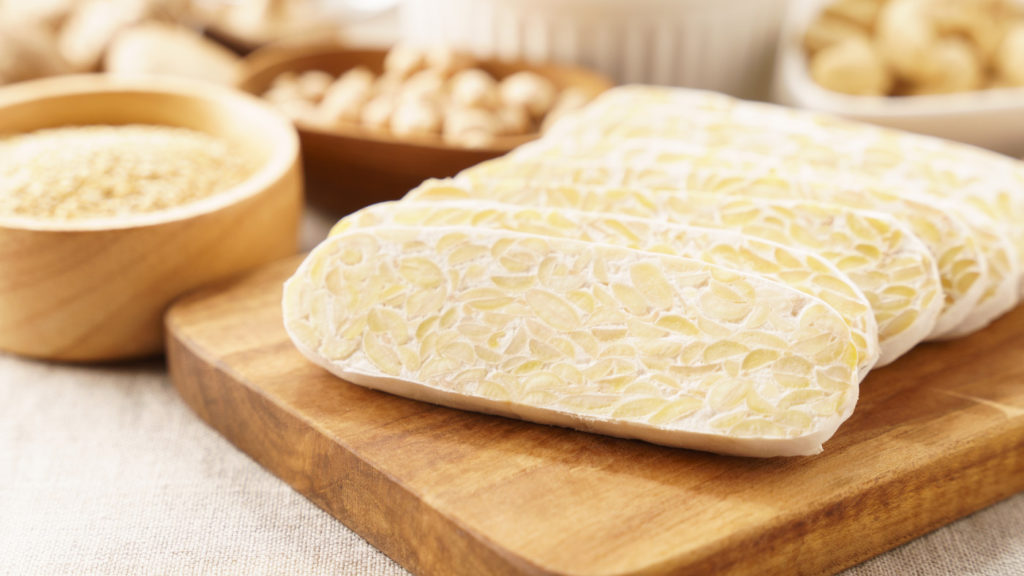Learn how to make natto at home! This ultra-nutritious food has benefits, texture, and flavour that leave no one indifferent.
This guide will quickly give you all the tools you need to easily make natto.
What Is Natto?
Natto (nattō-kin in Japanese) is a Japanese dish made from soybeans fermented by Bacillus subtilis bacteria. Fermentation transforms the soybeans, giving them a unique taste, smell, and texture.
Natto beans are wrapped in a silky, delicately stringy substance that resembles melted cheese. But, what does natto taste like? The flavour is subtly rich, with umami notes that tantalize the taste buds, and a distinctive aroma that reflects its fermented nature.
You either love it or hate it! Natto is an acquired taste, but it’s addictive for enthusiasts.
It is traditionally eaten for breakfast, mixed with hot rice, drizzled with soy sauce, and topped with mustard, making a highly nutritious meal packed with health benefits.
The Benefits of Homemade Natto
Natto is rich in many nutrients, including vitamin K2, which helps maintain heart and bone health (ref.).
Fermenting natto makes soybeans easier to digest and destroys their anti-nutrients (ref.). So you can enjoy the benefits of soy without the drawbacks.
Natto is also an ally of the microbiota. It contains billions of probiotic bacteria as well as prebiotic compounds, which support and nourish our microbiota. The microbiota plays important roles in the human body, including maintaining a healthy immune system and regulating blood cholesterol levels (ref.).
Discover all the benefits of natto in our article: The Benefits of Natto According to Science.
Ingredients to Make Natto
What is natto made of? You only need two ingredients to make these Japanese sticky beans: soybeans and natto culture.
Soybeans
Use whole dried soybeans. You can find them in health food stores or in bulk.
There are also soybeans sold specifically for making natto. These beans are smaller and produce milder natto, with a more accessible taste for beginners.
You can replace whole soybeans with dehulled soybeans or other legumes, but the results may not be as interesting.
Natto Culture
Natto culture contains B. subtilis bacteria and is used to inoculate soybeans to start the fermentation process.
You can buy natto culture online, or you can use some already fermented natto as a starter culture. This is called reculturing.
Equipment for Making Natto
Making natto requires very little equipment: Most of the necessary equipment is readily available in any kitchen. The main challenge is maintaining a constant temperature during fermentation.
Equipment needed:
- Large saucepan
- Stirring spoon
- Kettle
- Glass or stainless steel container
- Cloth (dishcloth or similar)
- Aluminum foil or plastic wrap
- Cooking thermometer (optional, but useful!)
- Incubator (more about this later)
Make sure your equipment is very clean! We recommend sanitizing all the equipment that will be used to make natto. If you have a dishwasher that runs hot, this is a quick and effective solution.
See our article on How to Clean and Sanitize Fermentation Equipment for more information.
Equipment for Incubating Natto
The most important thing to remember when preparing natto is to keep the soybeans warm during fermentation. They need to be kept at a temperature of between 37 and 45°C (99 to 113°F).
To do this, there are several types of incubators to choose from:
- Pressure cooker (Instant Pot type)
- Yogurt maker
- Dehydrator
- Cooler with hot water bottles
- Oven switched off with the light on
Whatever your strategy and equipment, just keep the incubation temperature between 37 and 45°C. To be sure, insert a thermometer into the soybeans to measure and adjust the incubator temperature as needed.
Steps for Preparing Natto
Preparing the Soybeans
To cook soybeans efficiently, start by soaking them for at least 6 hours, ideally overnight. Then rinse them thoroughly. There are two cooking options:
- In a saucepan with boiling water, cook for several hours until the beans are sufficiently tender.
- Using a pressure cooker, such as a Crock Pot, you can drastically reduce the cooking time to only 30 to 45 minutes.
Make sure the beans are soft and can be crushed between your fingers.
Sanitizing the Equipment
To sanitize, we recommend using a dishwasher or a food-grade sanitizer such as Io Star or Star San.
Adding Natto Culture to Cooked Beans
Natto culture needs a thermal shock to reactivate properly. Add the natto culture to very hot water, which is then mixed with the cooked beans.
Incubating Soybeans
Incubation allows the microorganisms to develop properly. Heat is essential! Fermentation usually takes between 12 and 24 hours. Keep natto warm and moist during fermentation.
Refrigerating Natto
Once fermentation is complete, put the natto in the fridge. It is best after being left to mature in the fridge for a few days.

Recipe for Homemade Natto
Equipment
- Large metal bowl
- Large metal spoon
- 3 or 4 glass dishes
- Plastic film
- Small spoon
Ingredients
- 4 cups soybeans
- ⅕ tsp. Natto starter culture
Steps
Preparing the Soybeans
- Rinse the beans.
- Soak the beans in twice their volume of cold water. Let them stand for at least 12 hours, or 24 hours if the ambient temperature is cold.
- Drain the beans and place them in a large saucepan.
- Cover the beans with water and cook until tender, this will take about 4 hours. Alternatively, use a pressure cooker and steam them for 45 minutes.
- The beans are ready when you can easily crush them between your fingers.
Sanitizing
- Wash and rinse your kitchen sink. Put the sink stopper and fill it with a gallon of water.
- Add 1 teaspoon of Star San to the water. If you don't have Star San, use an alternative method to sanitize.
- Soak all utensils (bowl, fermentation dish, spoon) for at least 2 minutes. Then remove the stopper and let them drain without rinsing.
Adding the Culture
- Bring water to boil in a kettle. Pour ½ cup of water into a small bowl and allow to cool for 5 minutes.
- Add 1/5 teaspoon of natto culture powder (0.1 g or 1 ml) to the water and mix well.
- While the beans are still very hot (around 80°C), add the water inoculated with the culture. It is important to add the natto culture while the beans are still very hot, as the thermal shock will allow the Bacillus spores to germinate while eliminating the undesirable bacteria.
- Mix well with a large spoon.
Fermentation
- Preheat your incubator at 40°C (oven, dehydrator, yogurt maker, etc.).
- Add a thin layer of beans to each container (about 1 to 2 cm).
- Place a cloth over the top of each container and fix a plastic film over it.
- Place the containers in the incubator and allow them to ferment for 12 hours.
- For a stronger flavour, let them ferment for up to 24 hours. Make sure that the temperature of 40°C remains constant throughout the fermentation period.
Notes
How To Store Natto?
Natto can be kept in the fridge for a week.
To enjoy it regularly, freeze natto in individual portions. Place the container in the fridge the day before. The natto fermented beans will be delicious the next morning.
How to Eat Natto
Natto is traditionally eaten for breakfast.
Whisk the natto with chopsticks to activate the filaments. The fermented sticky beans will taste even better!
Serve natto with a bowl of rice and side dishes like:
- Soy sauce
- Mustard
- Sliced green onions
- Fried eg
- Homemade kimchi
- Spicy chili oil
- Sesame oil
Enjoy your meal!
Get Started!
- Buy natto culture
- Read The Benefits of Natto According to Science
- Learn how to make miso and tempeh
- Discover the book “Miso, Tempeh, Natto“
- Buy koji, tempeh, natto, and sourdough equipment and cultures

